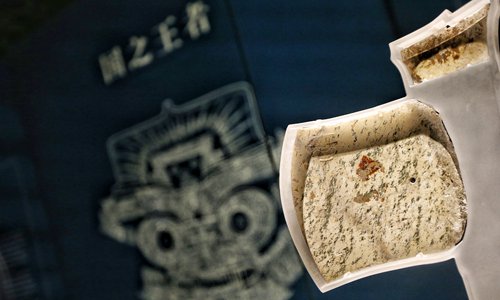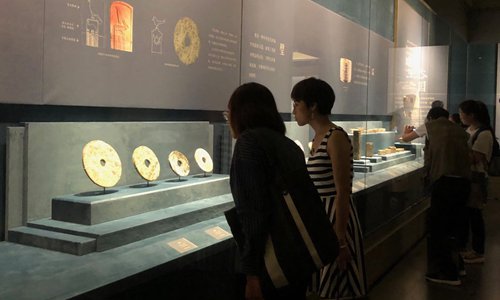‘Liangzhu and Ancient China: The 5,000-Year Civilization Demonstrated by Jades’ exhibition kicks off at the Palace Museum in Beijing

The King Yue Photo: IC

Visitors explore the Liangzhu and Ancient China: The 5,000-Year Civilization Demonstrated by Jades exhibition at the Palace Museum on Tuesday. Photo: Liu Zhongyin/GT
Liangzhu and Ancient China: The 5,000-Year Civilization Demonstrated by Jades exhibition kicked off at the Palace Museum in Beijing on Tuesday. This is the first exhibition of Liangzhu jade relics since the Archaeological Ruins of Liangzhu City was named a UNESCO World Heritage Site on July 6 at the 43rd session of the UNESCO World Heritage Committee in Baku, capital of Azerbaijan.Archaeological Ruins of Liangzhu City is located in the Yuhang district of Hangzhou, East China's Zhejiang Province. Located in the Yangtze River basin, the Late Neolithic ruins were initially discovered by Shi Xingeng, a scholar, in 1936. Archaeological exploration of the site has been carried out for more than eight decades.
The International Council on Monuments and Sites, a professional organization that offers advice to UNESCO on World Heritage Sites, commented that the Archaeological Ruins of Liangzhu City "provides unparalleled evidence for concepts of cultural identity, social and political organization, and the development of society and culture in the late Neolithic and early Bronze Age in China and the region" and sets "an outstanding example of early urban civilization."Liu Bin, the head of the Zhejiang provincial institute of archaeology, told media on Tuesday that the major items on display at the exhibition were discovered in important tombs in the inner city of Liangzhu, a section of the city discovered in 2007 that is four times as large as Beijing's Forbidden City.
Liangzhu jade is an important cultural product of the Liangzhu civilization. According to Liu, the jade artifacts discovered in tomb sites suggest that there were at least four social classes at that time. Among the tombs in the inner city, the Fanshan Mountain No.12 Tomb stood at the highest point in the hierarchy.
Kings of jade
Gao Menghe, the curator of the exhibition, noted at the opening ceremony that the use of jade in China can be traced back to more than 8,000 years ago, even longer than the history of using China. Jade is a spiritual symbol in Chinese culture, Gao added.
Liangzhu jades are regarded as the pinnacle of pre-history jade culture because of their large number, various categories and delicate designs.
Gao pointed out that there are three iconic jade objects in Liangzhu civilization: cong (jade tubes with quadrilateral exteriors), bi (jade disks) and yue (jade axes). According to Gao, cong first appeared in Liangzhu and became an exclusive symbol of the civilization, denoting the king's military, monarchy and divine rights.
The supreme rulers of Liangzhu society held both political and religious authority. What is special about the jades of the Liangzhu civilization are the engravings of a sacred emblem that is a combination of a divine god figure with a beast's face as well as how these engravings underwent a process of simplification.
The highlights of the exhibition are two objects: the King Yue and King Cong. These were both unearthed from the Fanshan Mountain No.12 Tomb. The King Yue is named so becuase it is the only piece to be engraved with two emblems, the sacred divine god figure emblem and a bird emblem, another sign of power in Liangzhu civilization. The King Cong gets its name because it is the heaviest and most exquisite cong discovered at the site so far.
Liu noted that they are presenting jades from both male and female members of the ruling class to deliver a balanced view of Liangzhu society.
Cultural inheritance
Featuring 260 items from 17 museums and archaeological institutes in nine provinces in China, the exhibition is the largest display of Liangzhu jade artifacts ever held.
Gao mentioned that the Liangzhu civilization extended to Northwest China 's Gansu Province and South China's Guangdong Province around 5,000 years ago, which shows its vast influence.
The exhibition also includes some jade or porcelain cong crafted during the Song (960-1279) and Qing (1644-1911) dynasties in imitation of those from the Liangzhu civilization as examples of the continuity of Chinese civilization.
Shan Jixiang, former director of the Place Museum, noted that the exhibition was special because relics from the most recently named World Heritage Site was being held at the Palace Museum, which houses the Forbidden City, one of the first Chinese sites named as a World Heritage Site.
"The collision of these two World Heritage sites may impact visitors' perception of our cultural heritage," Shan said.
"This is the peak season for the Palace Museum now that students are on summer vacation. The exhibition will run through the summer and the National Day Holiday [on October 1], a golden period of time to attract young people's attention and inspire them to learn more about the inheritance of the everlasting Chinese civilization," Shan added.
The exhibition will run until October 20.